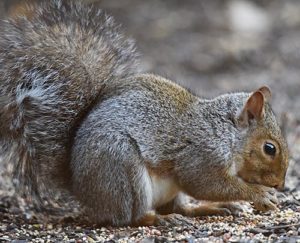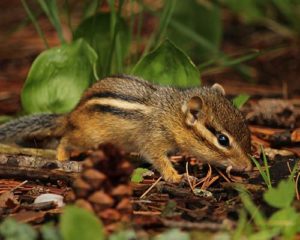If you are a regular reader of this blog, then it is probably because you appreciate pollinators and wildlife and enjoy seeing them on your property. However, that doesn’t mean we can’t sometimes become frustrated with some of those same critters. At times like that, it’s important to learn how we can better understand and manage or even prevent those frustrating behaviors. Learning to live with pollinators and wildlife, even when their actions frustrate us, is just as important as learning how to attract them.
If you’re like me, then squirrels and/or chipmunks are high on the list of sometimes (often) frustrating wildlife. I like squirrels and chipmunks and enjoy watching them. However, in the spring and fall, I am constantly having to re-plant seedlings that the squirrels and chipmunks have dug up. And I know that I’m not the only one that struggles with this problem. The internet is full of “solutions” to this problem – some more effective than others. But, before we talk about ways to discourage squirrels and chipmunks from digging up your plants, let’s talk about why they are doing it because understanding “why” can help us come up with effective solutions.
It’s common knowledge that squirrels and chipmunks eat a lot of nuts, berries, and seeds. However, that’s not all that they eat. Chipmunks also commonly eat earthworms, millipedes, snails, bulbs, fungi, and young vegetation. Squirrels are also known to eat adult and larval insects, tender buds and shoots, fungi, and bulbs or roots, although usually not to the same degree as chipmunks.

The caching behavior of squirrels and chipmunks is also legendary. This behavior helps ensure they have food available at times when it would otherwise be difficult to find. It also helps the forests where they live regenerate, because a large percentage of the cached nuts and seeds are forgotten. Many of these forgotten nuts and seeds end up germinating.
Their role in forest regeneration as a result of their caching behaviors makes squirrels and chipmunks are some of nature’s gardeners. Although that can be hard to appreciate when they insist on digging up our plants, even after we’ve re-planted the plant multiple times. When it comes to our plants, squirrels and chipmunks may be digging them up for a few different reasons and each reason suggests a potentially different method for discouraging the squirrels and chipmunks.
They could be looking at our plants as a direct source of food in the form of bulbs, roots, or tender young vegetation. In that case, creating some sort of protective cage or barrier until the plants are big enough that the squirrels and chipmunks are no longer interested may be the easiest and most effective method. However, I often find the plants wilted and tossed to the side, but not eaten. This suggests that the squirrels and chipmunks weren’t after my plant at all and that the seedling was dug up as a byproduct of what they were actually after.
Another reason that squirrels and/or chipmunks could be digging up your plants is that they are after something that is in the ground with your plants – bugs, fungi, other roots or bulbs, etc. In this case, addressing the reason the squirrels and chipmunks are digging in the vicinity of your plants should solve the problem. Or take the same approach as in the first case, and create some sort of barrier to keep the squirrels and chipmunks from getting to your plants.
However, the most common reason that squirrels and chipmunks dig up our plants is also the easiest one to manage for in my opinion. In nature, sot, easy-to-dig-in bare dirt doesn’t occur that often. When it does occur, it can be an easy place to dig and hide a nut, or it can represent a place that someone else may have recently hidden a nut and which you can now confiscate for yourself.
So, when a squirrel or chipmunk finds a potted plant in the fall, it may see a great place to bury a nut. Along the same lines, when we plant a tender, new seedling in the early spring (when nuts, seeds, and berries aren’t as plentiful as they were a few months before), squirrels and chipmunks in the area may smell the exposed dirt. To them, the exposed dirt may suggest a place where another critter recently dug up some yummy, leftover, fall goodies or perhaps buried something yummy that they just found – either way it’s worth checking out.

In cases where the bare dirt is the stimulus for the unwanted behavior, simply putting something over the bare dirt can be an easy and effective way to discourage squirrels and chipmunks from digging up your plants. When planting in the ground in the early spring, I’ve had good luck with spreading a thin layer of leftover fall leaves around my new transplants and any bare dirt that I exposed. Putting a layer of rocks or pebbles for several inches around the plant can also be a good barrier and can even be done with potted plants. When planting seeds, putting chicken wire or something similar over the top of the container if planting in a pot, or making a frame with a chicken wire covering that you can set on the ground over your newly planted seeds can also work.
There are commercial repellants, but I’ve never tried them and am not sure how effective they would be. At least for me, most of my issues occur in the spring and fall – our rainy seasons. Repellants need to be re-applied periodically, especially after it rains. I just don’t have the time or interest to be continually reapplying repellants. However, just because that’s not the method I choose doesn’t mean that it might not be a good option for you. If you decide to go that route, do your research. Different people report different levels of effectiveness for different repellants.
Other more direct approaches, such as live trapping the squirrels and chipmunks are also sometimes suggested. If you decide to go that route, first make sure you check with your state’s Fish and Wildlife Department or Department of Natural Resources. In most states, there are regulations regarding what can or cannot be done to these animals. Second, please do NOT relocate the animals that you trap. Many states have laws against relocating animals, again check with your state’s fish and wildlife agency. However, it still isn’t a good idea to relocate a wild animal, even if your state doesn’t have laws against it.
No location has unlimited resources which can support an unlimited number of animals. There is always a limit to how many animals of a given species any location can support. In biology and ecology, we call that limit the carrying capacity. In the eastern U.S., squirrels and chipmunks are plentiful. Pretty much everywhere has as many squirrels and chipmunks as the place can support. When you relocate a wild animal to a new location, you are dumping it off in an unknown area where it doesn’t know the best sources of food, water, and shelter, and where it is most likely trespassing on someone else’s territory because the carrying capacity for that area has likely already been reached.
Most backyard wildlife that are relocated end up dying as a direct result of starvation, fighting with other animals who already have established territories in that area, or while trying to get back to their own territory (i.e. your yard). If an animal is causing an unacceptable amount of damage and you can’t find a way to discourage or minimize the damaging behavior, then the most humane thing you can do is give it a quick death rather than let it suffer in an unfamiliar location. (Remember to know and follow any relevant laws.)
While extreme actions may sometimes be necessary, more often there are relatively simple steps you can take to minimize the unwanted behavior. This is especially true when it comes to something like trying to discourage squirrels and chipmunks from digging up your plants. In this case, covering the bare soil around your newly planted seedlings or creating a barrier of some sort above the bare ground can go a long way towards helping keep your plants in the ground and safe from the squirrels and chipmunks who are just doing what they’ve done always done in the wild.

Backyard Ecology: Exploring Nature in Your Backyard
Nature isn’t just “out there.” It’s all around us, including right outside our doors. Hi, my name is Shannon Trimboli, and I am the host of Backyard Ecology. I live in southcentral Kentucky and am a wildlife biologist, educator, author, beekeeper, and owner of a nursery specializing in plants for pollinators and wildlife conservation. I invite you to join me as we ignite our curiosity and natural wonder, explore our yards and communities, and improve our local pollinator and wildlife habitat. Learn more or subscribe to my email list at www.backyardecology.net.

Leave a Reply